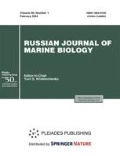Abstract
It has been shown that the survival capabilities of the bacteria Listeria monocytogenes and Yersinia pseudotuberculosis in water environments is different depending upon the strain of the bacteria. When entering sea or river water, the pathogenic bacteria must withstand keen competition against numerous saprophytic microflora. It is found that different strains of Listeria and Yersinia adapted to low positive temperatures can reproduce in non-sterile sea and river water under low positive temperatures and remain there for long periods of time.
Similar content being viewed by others
REFERENCES
Gershun, V.I., Viability of Listeria in Water, Sib. Vestn. S.-Kh. Nauki, 1979, no. 6, pp. 48-50.
Gershun, V.I., Effects of Abiotic Factors on the Viability of Listeria in the Soil, Sib. Vestn. S.-Kh. Nauki, 1980, no. 3, pp. 78-81.
Zaitseva, E.A. and Terekhova, V.E., Ecological-Epidemiological Peculiarities of Listeria monocytogenes in Primorye Province, Tikhookean. Med. Zhurn., 2001, no. 2, pp. 29-31.
Korolyuk, A.M., Serologicheskaya diagnostika psevdotuberkuleza (skarlatinopodobnoi likhoradki (Serological Diagnostics of Pseudotuberculosis (Far-Eastern scarlet-fever-like fever)), Abstract Cand. Sci. Diss. (Biol.), Leningrad, 1972.
Kuznetsov, V.G., On Isolation of Yersinia pseudotuber-culosis from Freshwater Fish in Primorye Province, Zhurn. Mikrobiol., 1980, no. 10, pp. 113-114.
Kuznetsov, V.G. and Timchenko, N.F., Relationships Between the Bacteria of the Genus Yersinia in Water Environment, Zhurn. Mikrobiol., 1998, no. 6, pp. 26-29.
Lanskaya, L.A., Cultivation of Algae, Ekologicheskaya fiziologiya morskikh planktonnykh vodoroslei (Ecological Physiology of Marine Plankton Algae), Kiev: Naukova Dumka, 1971, pp. 5-21.
Litvin, V.Yu., General Patterns and Mechanisms of Survival of Pathogenic Microorganisms in Soil and Water Ecosystems, Ekologiya vozbuditelei sapronozov (Ecology of Etiological Agents of Sapronoses), Moscow: Meditsina, 1988, pp. 20-34.
Pomanskaya, A.A., On the Reproduction of Listeria in the Water, Zhurn. Mikrobiol., 1962, no. 9, pp. 102-105.
Shubin, F.N., Khoroshko, V.A., Rozmakov, A.P., et al., Water and Hydrobionts As an Environment for Yersinia pseudotuberculosis, Zhurn. Mikrobiol., 1981, no. 10, pp. 26-29.
Holt, J.G., Krieg, N.R., Sneath, P.H.A., et al., (Eds.), Bergey's Manual of Determinative Bacteriology, 9th ed., Moscow: Mir, 1997, pp. 575.
Goulet, V., Espasze, T., and Bastide, I., Human Listeriosis in France in 1987, Acta Microbiol. Hung., 1989, vol. 36, no. 2–3, pp. 173-176.
Hartemink, R. and Georgsson, F., Incidence of Listeria Species in Seafood and Seafood Salads, Int. J. Food Microbiol., 1991, vol. 12, pp. 189-195.
Helmke, E. and Weyland, H., Abundance, Distribution andActivity ofAntarctic Sea Ice Bacteria During Winter, Abstr. 6th Int. Symp. Microb. Ecology (ISME-6), Barselona, Spain, 1992, p. 272.
Liston, J., Microbial Hazards of Seafood Consumption: Toxins, Bacteria and Viruses are the Principal Causes of Seafood-Borne Diseases, Food Technol., 1990, vol. 44, no. 12, pp. 58-62.
Luppi, A., Bucci, G., Maini, P., and Rocourrt, J., Ecological Survey of Listeria in the Ferrara Area (Northern Italy), Zbl. Bakteriol., Mikrobiol., Hyg., ser. A, 1988, vol. 269, no. 2, pp. 58-62.
Nakkama, F., Maruyama, T., Kkokubo, Y., Iida, T., and Umekki, F., Incidence of Listeria monocytogenes in Foods in Japan, Listeria 1992: 11th Int. Symp. Probl. Listeriosis, Copenhagen, 11–14 May, 1992: BookAbstr., S.I., S.A., 1992, pp. 317-318.
Rorvik, L.M. and Yndestad, M., Listeria monocytogenes in Foods in Norway, Int. J. Food Microbiol., 1991, vol. 13, no. 2, pp. 97-104.
Smith, R.E.H. and Clement, P., Heterotrophic Activity and Bacterial Productivity in Assemblages of Microbes From Sea Ice in High Arctic, Polar Biol., 1990, vol. 10, no. 5, pp. 351-357.
Weiss, J. and Seeliger, H., Incidence of Listeria monocytogenes in Nature, Appl. Microbiol., 1975, vol. 30, no. 1, pp. 29-32.
Youshimizu, M. and Kimura, T., Study of Intestinal Microflora of Salmonids, Fish Pathol., 1976, vol. 10, no. 2, pp. 243-259.
Author information
Authors and Affiliations
Rights and permissions
About this article
Cite this article
Buzoleva, L.S., Terekhova, V.E. Survivorship of Different Strains of the Bacteria Listeria monocytogenesis and Yersinia pseudotuberculosisin Sea and River Water. Russian Journal of Marine Biology 28, 259–262 (2002). https://doi.org/10.1023/A:1020225227751
Issue Date:
DOI: https://doi.org/10.1023/A:1020225227751




